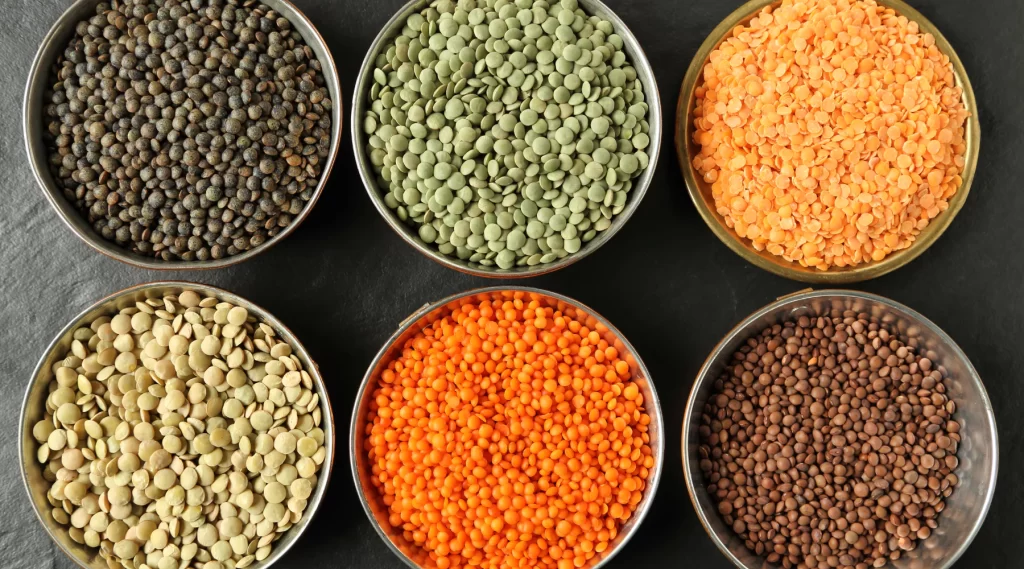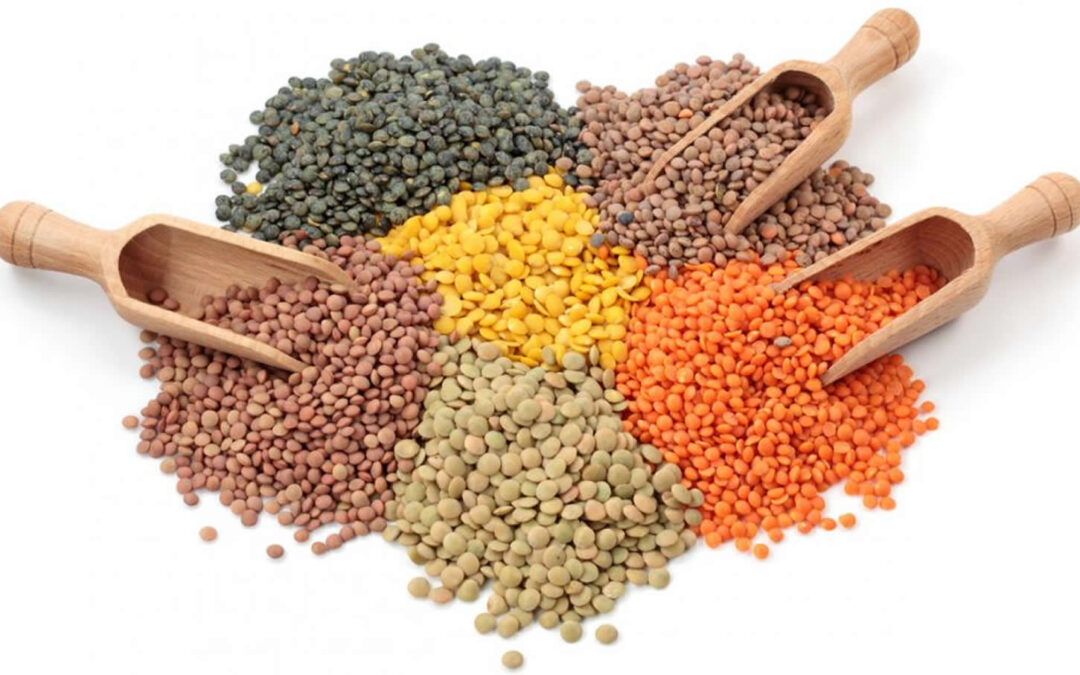Lentils
Lentils are a type of legume, and they are often used in cooking for their high protein and fiber content. They come in various colors, including green, brown, red, and black, and they are a staple in many cuisines around the world.
Lentils Meaning in Urdu:
In Urdu, lentils are called “ دالیں”(Daal).
Lentils Protein:
Lentils are an excellent source of plant-based protein. They contain about 25% protein by weight, making them one of the highest protein legumes. This makes them a valuable food source, especially for vegetarians and vegans, as they can be used to replace meat in many dishes.
Lentils Types:
There are several types of lentils, and they vary in size, color, and taste. Here are some common types:
Green Lentils: These are larger in size and have a mild, earthy flavor. They hold their shape well when cooked and are often used in salads or as a side dish.
Brown Lentils: Brown lentils are the most common variety. They cook relatively quickly and are used in a wide range of dishes, including soups, stews, and curries.
Red Lentils: These lentils cook quickly and become soft and mushy when boiled. They are often used in soups, dals, and purees.
Black Lentils (Beluga Lentils): These lentils are small and black in color, resembling caviar, and they have a rich, earthy flavor. They are often used in salads and side dishes.
French Green Lentils (Puy Lentils): These small, dark green lentils are known for their peppery flavor. They hold their shape well when cooked and are often used in salads and as a side dish.
Yellow Lentils (Toor Dal): Yellow lentils are commonly used in Indian cuisine and are often split and hulled. They are used to make various types of dals and are a staple in Indian cooking.
Lentils Recipe:
Here’s a simple recipe for cooking lentils:
Ingredients:
1 cup dried lentils (any color)
2 cups water or vegetable broth
1 small onion, finely chopped
2 cloves garlic, minced
1 carrot, finely chopped (optional)
1 celery stalk, finely chopped (optional)
1 bay leaf (optional)
Salt and pepper to taste
1-2 tablespoons olive oil (optional)
Fresh herbs like thyme, rosemary, or parsley (optional)
Instructions:
Rinse the lentils under cold water and remove any debris or stones.
In a pot, heat the olive oil over medium heat. Add the onions and garlic and sauté until they become translucent.
Add the lentils, water or vegetable broth, and any optional ingredients like carrots, celery, and bay leaf.
Bring the mixture to a boil and then reduce the heat to a simmer.
Cover the pot and cook for about 20-30 minutes, or until the lentils are tender but not mushy. Cooking times may vary depending on the type of lentils you use.
Season with salt and pepper to taste.
Remove the bay leaf and discard it.
Serve your cooked lentils hot, garnished with fresh herbs if desired.
Lentils Nutrition:
Lentils are highly nutritious and are an excellent source of plant-based protein, fiber, vitamins, and minerals. They are low in fat and are a good source of complex carbohydrates. Lentils are also a great source of the following nutrients:
Protein
Fiber
Folate (Vitamin B9)
Iron
Potassium
Magnesium
Phosphorus
B Vitamins
Zinc
Lentils Calories:
The calorie content of lentils can vary slightly depending on the type and the way they are prepared. On average, cooked lentils contain about 230-240 calories per cup (200 grams).

What Are Lentils:
Lentils are small, lens-shaped seeds that belong to the legume family. They come in various colors, including brown, green, red, and black. Lentils are a staple in many cuisines worldwide and are valued for their versatility, affordability, and nutritional value. They are commonly used in soups, stews, curries, salads, and a wide range of other dishes. Lentils are a rich source of plant-based protein and are often included in vegetarian and vegan diets. They are known for their earthy flavor and the ability to absorb the flavors of the ingredients they are cooked with.
Origin of Lentils:
Lentils have a long history and are one of the oldest cultivated crops. Their exact origin is not precisely known, but it is believed that lentils originated in the Near East and were one of the first crops to be domesticated. They have been grown for over 8,000 years and were an essential source of sustenance in ancient civilizations, including those in the Mediterranean, Middle East, and India. Lentils have been grown and consumed in various forms across many cultures throughout history.
Lentil Uses:
Lentils have a wide range of culinary uses and are a versatile ingredient in many dishes. Some common uses include:
Soups and Stews: Lentils are commonly used to add flavor, texture, and nutrition to soups and stews. They cook relatively quickly and can be added to a variety of recipes.
Curries: Lentils are a key ingredient in many Indian and South Asian curries. They can be used in both vegetarian and non-vegetarian dishes.
Salads: Cooked and cooled lentils can be added to salads for an extra protein boost and a hearty, earthy flavor.
Side Dishes: Lentils can be served as a side dish, seasoned with herbs and spices, or combined with vegetables.
Dips and Spreads: Lentils can be used to make dips and spreads, such as hummus or lentil-based spreads with various seasonings.
Burgers and Patties: Lentils can be used to make vegetarian or vegan burgers and patties as a meat substitute.
Baking: Some recipes use lentil flour in baking, especially in gluten-free recipes.
Benefits of Lentils for Skin:
Lentils offer several potential benefits for the skin:
Anti-Aging: Lentils are rich in antioxidants like vitamin C and quercetin, which can help protect the skin from oxidative stress and signs of aging.
Collagen Production: The protein and iron in lentils can contribute to collagen production, which is important for skin elasticity.
Acne Prevention: The zinc in lentils may help reduce inflammation and the formation of acne.
Exfoliation: Lentils can be ground into a fine powder and used as a natural exfoliant in homemade face masks or scrubs to remove dead skin cells.
Moisturization: Lentils can be included in skincare masks to promote hydration and prevent dryness.
Benefits of Lentils for Hair:
Lentils can provide several benefits for hair health:
Protein Source: Lentils are a good source of plant-based protein, which is essential for hair growth and strength.
Iron Content: The iron in lentils helps in maintaining healthy hair by promoting circulation and preventing hair loss due to iron deficiency.
Biotin and Folate: These nutrients in lentils are essential for promoting healthy hair growth and preventing hair thinning.
Overall Nutrient Profile: Lentils contain various vitamins and minerals that support overall health, which can indirectly benefit hair by ensuring the body’s proper functioning.
Lentil Scientific Name and Family:
Scientific Name: Lens culinaris
Family: Fabaceae
Lentils Protein per 100g:
The protein content of lentils can vary slightly depending on the type and variety of lentils, but on average, lentils contain about 9-10 grams of protein per 100 grams when cooked. This makes them an excellent source of plant-based protein.
Lentils Soup:
Lentil soup is a popular and nutritious dish made from lentils. Here’s a basic recipe for lentil soup:
Ingredients:
1 cup dried lentils (red, brown, green, or your choice)
4 cups vegetable broth or water
1 onion, chopped
2 cloves garlic, minced
1 carrot, chopped
1 celery stalk, chopped
1 bay leaf
1 teaspoon ground cumin (optional)
1 teaspoon ground coriander (optional)
Salt and pepper to taste
Olive oil for sautéing
Instructions:
Rinse the lentils under cold water and set them aside.
In a large pot, heat olive oil over medium heat. Add the chopped onion, garlic, carrot, and celery, and sauté for a few minutes until the vegetables begin to soften.
Add the rinsed lentils, vegetable broth or water, bay leaf, and optional spices (cumin and coriander).
Bring the mixture to a boil, then reduce the heat to a simmer.
Cover the pot and let it cook for about 20-30 minutes, or until the lentils are tender.
Remove the bay leaf, and season the soup with salt and pepper to taste.
You can also use an immersion blender to partially blend the soup for a smoother texture if desired.
Serve your lentil soup hot, garnished with fresh herbs or a drizzle of olive oil.
Lentils Vitamins:
Lentils are a good source of various vitamins, including:
Vitamin B1 (Thiamine): Thiamine is important for energy metabolism.
Vitamin B3 (Niacin): Niacin plays a role in the health of your skin, nerves, and digestive system.
Vitamin B5 (Pantothenic Acid): Pantothenic acid is involved in energy production and the synthesis of fatty acids.
Vitamin B6 (Pyridoxine): Pyridoxine is essential for various enzymatic reactions in the body.
Folate (Vitamin B9): Folate is important for DNA synthesis and repair, and it’s especially important during pregnancy.
Vitamin K: Lentils contain a small amount of vitamin K, which is essential for blood clotting and bone health.
Lentils for Weight Loss:
Lentils can be a beneficial part of a weight loss diet for several reasons:
High Fiber Content: Lentils are rich in fiber, which can help you feel full and satisfied, reducing the likelihood of overeating.
Low in Calories: Lentils are relatively low in calories while providing essential nutrients, making them a good choice for calorie-conscious individuals.
Protein Source: Lentils offer plant-based protein that can support muscle maintenance and boost your metabolism.
Satiety: The combination of fiber and protein in lentils can help control hunger and reduce snacking between meals.
Lentils Advantages and Disadvantages: Advantages of lentils:
Nutrient-Rich: Lentils are rich in protein, fiber, vitamins, and minerals.
Versatility: They can be used in a wide variety of dishes.
Affordable: Lentils are cost-effective and readily available.
Disadvantages of lentils:
Flatulence: Some people may experience digestive discomfort, such as gas and bloating, when consuming lentils. Soaking and thorough cooking can help mitigate this.
Antinutrients: Lentils contain antinutrients like phytic acid, which can reduce mineral absorption. Soaking or cooking can help reduce antinutrient levels.
Allergies: Lentil allergies are rare but can occur in some individuals.
Lentils for High Blood Pressure:
Lentils can be beneficial for individuals with high blood pressure due to their nutrient profile, particularly their high potassium and low sodium content. Potassium is known to help regulate blood pressure by counteracting the effects of sodium. Additionally, the fiber in lentils can contribute to heart health by helping to lower cholesterol levels.
Lentils for Babies:
Lentils can be introduced to a baby’s diet as a source of protein, fiber, and various nutrients. However, it’s essential to prepare lentils in a way that is suitable for a baby’s age and stage of development. Lentils should be thoroughly cooked and mashed or pureed for infants who are just starting on solid foods. As the baby grows, lentils can be served in more varied forms, such as in soups or as part of vegetable and lentil purees.
Lentils in Medicine (Medical Use):
Lentils are not typically used as a medical treatment but are recognized for their health benefits. In traditional medicine, lentils have been used for their nutritive properties. They can play a role in maintaining overall health, promoting heart health, and managing conditions like diabetes due to their low glycemic index and high fiber content. However, if you have specific medical concerns, it’s important to consult with a healthcare professional for guidance on dietary choices and treatments.

